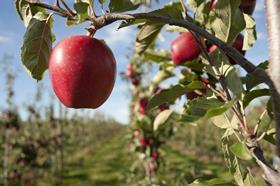
Unprecedented heat and worsening drought may prompt a revision of Australia’s apple and pear crop estimate for 2019.
A forecast compiled by AgFirst and the Hort Innovation-administrated Apple and Pear Fund initially predicted the overall crop volume to climb 8 per cent year-on-year.
However, the hottest January recorded in Victoria’s key Goulburn Valley production hub has prompted many to question whether the crop will live up to its early potential.
Michael Crisera, grower services manager at Fruit Growers Victoria, outlined the impact that heat can have on fruit in a recent article published via Apple and Pear Australia’s (APAL) weekly publication, Industry Juice.
“As fruit gets close to harvest, heat stress can be an issue,” said Michael Crisera, grower services manager at Fruit Growers Victoria. “Once temperatures exceed 36-37oC, the stress inhibits the trees’ maturity, which impacts fruit size.”
Further north, the apple and pear growing community around the township of Stanthorpe in Queensland are experiencing one of their driest spells in recent memory.
“In the early-80s we probably went as long without water, but this year we’ve also had to cope with daily temperatures over 35 degrees,” said Stanthorpe local and manager of P Savio & Co, Rosie Savio.
“A lot of growers in these parts have been trucking water in for their apples for over a month now – vegetable growers even longer. The hardest part is the not knowing when the rains will come.”
Reports suggest growers in heat affected regions will be harvesting smaller fruit, which will ultimately drive gross tonnes down.
“It’s been a very challenging season and we’re still only eight weeks in,” said APAL CEO, Phil Turnbull, via Industry Juice.
“City-based consumers equate images of starving sheep and cattle with drought, but many have never considered the commercial impact prolonged water shortagehas on permanent tree crops, or what it might do to our supply of apples and pears.
Turnbull renewed APAL’s calls for state and federal governments to support the industry via the introduction of a long-term national netting programme.
“Studies show netting can reduce water consumption by up to 20 per cent and protect against extreme weather conditions, including drought, sunburn, hail frost and bird and flying fox infestations,” Turnbull explained.



